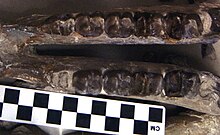| Nexuotapirus | |
|---|---|

| |
| Nexuotapirus robustus jawbone | |
|
Scientific classification
| |
| Domain: | Eukaryota |
| Kingdom: | Animalia |
| Phylum: | Chordata |
| Class: | Mammalia |
| Order: | Perissodactyla |
| Family: | Tapiridae |
| Genus: | †
Nexuotapirus Albright, 1998 [1] |
| Type species | |
| †Nexuotapirus marslandensis Schoch, 1984
| |
| Species | |
| |
Nexuotapirus is an extinct genus of tapir from the Late Oligocene and Early Miocene of North America.
Taxonomy
Nexuotapirus was erected in 1998. The type species, N. marslandensis, was originally classified under Miotapirus. The second species, N. robustus, was originally placed in Protapirus but was also moved to Nexuotapirus based on comparable lower dentition. [2]
Description
Nexuotapirus shows both plesiomorphic and derived features compared to other early tapirs, making its exact relationship with them difficult to place. [3]
Primitive traits of the genus include less molar-like premolars and incisive foramina that extend posteriorly through the postcanine diastema, as well as a braincase that tapers towards the back. More advanced features include deep retraction of the nasal incision, nasal shortening, frontal shortening, and reduction of the supraorbital process, features comparable to the modern Tapirus. [2]
References
- ^ "Nexuotapirus". Fossilworks.
- ^ a b Albright, L.B. (1998). "New genus of tapir (Mammalia: Tapiridae) from the Arikareean (earliest Miocene) of the Texas Coastal Plain". Journal of Vertebrate Paleontology. 18 (1): 200–217. doi: 10.1080/02724634.1998.10011044.
- ^ Journal of Vertebrate Paleontology: Volume 18, Issues 1-2 1998. University of Oklahoma. 1998.